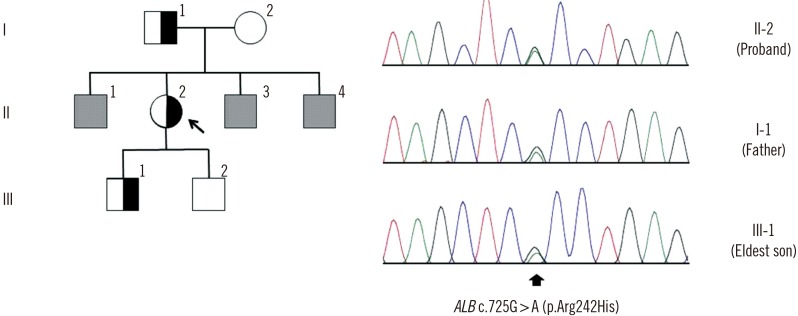Ann Lab Med.
2017 Jan;37(1):63-65. 10.3343/alm.2017.37.1.63.
First Report of Familial Dysalbuminemic Hyperthyroxinemia With an ALB Variant
- Affiliations
-
- 1Division of Endocrinology and Metabolism, Department of Medicine, Thyroid Center, Samsung Medical Center, Sungkyunkwan University School of Medicine, Seoul, Korea. swkimmd@skku.edu
- 2Division of Endocrinology and Metabolism, Department of Medicine, Gyeongsang National University School of Medicine, Jinju, Korea.
- 3Department of Laboratory Medicine and Genetics, Samsung Medical Center, Sungkyunkwan University School of Medicine, Seoul, Korea. changski@skku.edu
- KMID: 2373616
- DOI: http://doi.org/10.3343/alm.2017.37.1.63
Abstract
- Familial dysalbuminemic hyperthyroxinemia (FDH) is an inherited disease characterized by increased circulating total thyroxine (T4) levels and normal physiological thyroid function. Heterozygous albumin gene (ALB) variants have been reported to be the underlying cause of FDH. To our knowledge, there have been no confirmed FDH cases in Korea. We recently observed a female patient with mild T4 elevation (1.2 to 1.4-fold) and variable levels of free T4 according to different assay methods. Upon Sanger sequencing of her ALB, a heterozygous c.725G>A (p.Arg242His) variant was identified. The patient's father and eldest son had similar thyroid function test results and were confirmed to have the same variant. Although the prevalence of FDH might be very low in the Korean population, clinical suspicion is important to avoid unnecessary evaluation and treatment.
Keyword
MeSH Terms
Figure
Reference
-
1. Jensen IW, Faber J. Familial dysalbuminaemic hyperthyroxinaemia: a review. J R Soc Med. 1988; 81:34–37. PMID: 3278117.2. Wood DF, Zalin AM, Ratcliffe WA, Sheppard MC. Elevation of free thyroxine measurements in patients without thyrotoxicosis. Q J Med. 1987; 65:863–870. PMID: 3449890.3. Petersen CE, Scottolini AG, Cody LR, Mandel M, Reimer N, Bhagavan NV. A point mutation in the human serum albumin gene results in familial dysalbuminaemic hyperthyroxinaemia. J Med Genet. 1994; 31:355–359. PMID: 8064810.4. Sunthornthepvarakul T, Angkeow P, Weiss RE, Hayashi Y, Refetoff S. An identical missense mutation in the albumin gene results in familial dysalbuminemic hyperthyroxinemia in 8 unrelated families. Biochem Biophys Res Commun. 1994; 202:781–787. PMID: 8048949.5. DeCosimo DR, Fang SL, Braverman LE. Prevalence of familial dysalbuminemic hyperthyroxinemia in Hispanics. Ann Intern Med. 1987; 107:780–781.6. Tiu SC, Choi KL, Shek CC, Lau TC. A Chinese family with familial dysalbuminaemic hyperthyroxinaemia. Hong Kong Med J. 2003; 9:464–467. PMID: 14660816.7. Wada N, Chiba H, Shimizu C, Kijima H, Kubo M, Koike T. A novel missense mutation in codon 218 of the albumin gene in a distinct phenotype of familial dysalbuminemic hyperthyroxinemia in a Japanese kindred. J Clin Endocrinol Metab. 1997; 82:3246–3250. PMID: 9329347.8. Pannain S, Feldman M, Eiholzer U, Weiss RE, Scherberg NH, Refetoff S. Familial dysalbuminemic hyperthyroxinemia in a Swiss family caused by a mutant albumin (R218P) shows an apparent discrepancy between serum concentration and affinity for thyroxine. J Clin Endocrinol Metab. 2000; 85:2786–2792. PMID: 10946882.9. Sunthornthepvarakul T, Likitmaskul S, Ngowngarmratana S, Angsusingha K, Kitvitayasak S, Scherberg NH, et al. Familial dysalbuminemic hypertriiodothyroninemia: a new, dominantly inherited albumin defect. J Clin Endocrinol Metab. 1998; 83:1448–1454. PMID: 9589637.10. Greenberg SM, Ferrara AM, Nicholas ES, Dumitrescu AM, Cody V, Weiss RE, et al. A novel mutation in the Albumin gene (R218S) causing familial dysalbuminemic hyperthyroxinemia in a family of Bangladeshi extraction. Thyroid. 2014; 24:945–950. PMID: 24494774.11. Schoenmakers N, Moran C, Campi I, Agostini M, Bacon O, Rajanayagam O, et al. A novel albumin gene mutation (R222I) in familial dysalbuminemic hyperthyroxinemia. J Clin Endocrinol Metab. 2014; 99:E1381–E1386. PMID: 24646103.12. Cartwright D, O'Shea P, Rajanayagam O, Agostini M, Barker P, Moran C, et al. Familial dysalbuminemic hyperthyroxinemia: a persistent diagnostic challenge. Clin Chem. 2009; 55:1044–1046. PMID: 19282355.13. Ross HA, de Rijke YB, Sweep FC. Spuriously high free thyroxine values in familial dysalbuminemic hyperthyroxinemia. Clin Chem. 2011; 57:524–525. PMID: 21149501.
- Full Text Links
- Actions
-
Cited
- CITED
-
- Close
- Share
- Similar articles
-
- Familial Dysalbuminemic Hyperthyroxinemia by Albumin Gene Variant (R242H) in a 19-Year-Old Male: A Case Report
- Anesthetic experience in a clinically euthyroid patient with hyperthyroxinemia and suspected impairment of T4 to T3 conversion: a case report
- Cribriform-Morular Variant of Papillary Thyroid Carcinoma Associated with Familial Adenomatous Polyposis
- A Novel Adenomatous Polyposis Coli Gene Mutation of Cribriform-Morular Variant Papillary Thyroid Carcinoma: A Case Report
- Long-term outcomes of intraoperative and perioperative albendazole treatment in hepatic hydatidosis: single center experience


